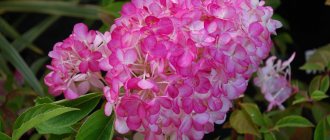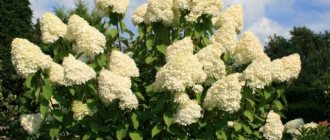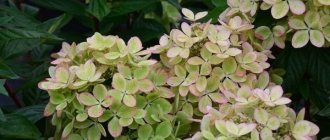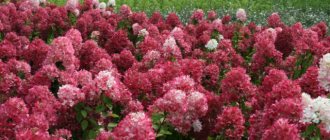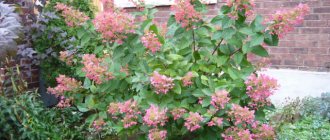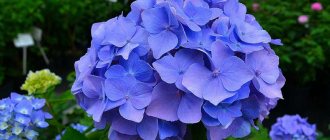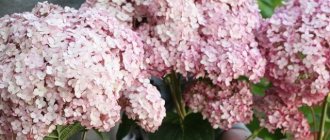Hydrangea climbing Miranda is one of the most beautiful plant varieties. It is distinguished by its beautiful appearance; it is a deciduous vine that climbs walls, trees, and also creeps along the ground. The winter-hardy plant is not afraid of winds and loves moisture. Taking care of it is not difficult.
Miranda differs from other varieties in its vine-like structure
Description of hydrangea Miranda
Hydrangea Miranda does not have a trunk, but it has aerial roots, with the help of which it “crawls” up all kinds of supports - walls, fences, trees. The foliage is green-light green, shiny, jagged. The veins are clearly visible in the center. The leaves of the petiolate hydrangea Miranda are small in size; together with the stem they form a vine, about 4.5 m long. In autumn, the foliage turns golden yellow and falls in November.
The inflorescences are usually white, flat, about 25 cm in diameter. Individual flowers are only 2 cm in diameter and emit a sweet scent, attracting bees.
How can climbing hydrangea replace heat-loving vines?
Every owner wants to have a shady gazebo on a country plot near the house, where in the summer they can hide from the sun's rays, or a corner of the garden hidden from prying eyes behind a green screen. And sometimes you need to quickly zone a space with a green hedge or disguise minor defects in the fence. The choice of climbing annual and perennial plants is huge and most gardeners traditionally choose various varieties of heat-loving clematis, climbing roses or ivy for vertical gardening. Almost immediately they are faced with the need to annually remove the plants from their support and cover them for the winter. In harsh winters, many plants freeze or rot in the shelter, grow slowly and bloom poorly, especially in shady areas.
Andrea_44 / Flickr.com
Meanwhile, such an unpretentious vine as petiole hydrangea (Hydrangea petiolaris) has been completely undeservedly forgotten. Experts believe that a more powerful and spectacular frost-resistant vine capable of growing in the climate of the middle zone simply does not exist. Climbing hydrangea can withstand frosts down to -35 0C. This is an excellent plant for a shady garden, capable of growing as a groundcover without support, completely covering the entire available area. Sometimes it blooms already in the second or third year after planting. Petiolate hydrangea blooms in June-July. White flowers are collected in flat, corymbose inflorescences that completely cover the vine. The sepals of sterile flowers gradually turn pink and remain on the plant until the end of summer.
Mike Freedman / Flickr.com
For petiole hydrangea, you definitely need a powerful support, preferably stone or brick. The plant produces a mass of aerial roots and suckers, with which it is firmly attached to the support, so the hydrangea is immediately planted in a permanent place. The plant tolerates deep shade and pressure from the roots of larger trees well, so it is loved by designers on old sites in combination with ship pines, larches or huge oaks. The tallest variety “Petiolaris” with bright green leaves grows up to 25 m in height. And in the “Skylands Giant” variety, the inflorescences reach 25 cm in diameter.
J Mark Dodds/Flickr.com
In contrast to the species form, variegated varieties rise along the support to a height of up to 10-15 m. The varieties “Miranda” and “Firefly” have a green-yellow bordering uneven light stripe along the edge of the leaves and veins of the same color. "Miranda" has slightly smaller leaves. The new variegated variety 'Silver Lining' has blue-green leaves with a creamy white edge. These varieties have a light sweet aroma that attracts bees and bumblebees to the garden. These hydrangeas are climbing and very decorative as a lemon or gray accent in a landscape.
Leonora (Ellie) Enking / Flickr.com
The flowers of the slow-growing variety Cordifolia also smell like honey. Plants planted singly spread along the ground, reach a height of 0.5 m, bushes grow up to 5 m in width. On trees and walls, plants of this variety can rise up to 3 m.
Less frost-resistant is the unusual hydrangea (Hydrangea anomala), which is also often sold under the name climbing hydrangea. The most famous variety is “Crug coral” with soft pink inflorescences and bronze-green leaves. Another variety, “Winter Surprise,” is evergreen, its leaves turn a rich red color in the fall.
Linda De Volder / Flickr.com
Unfortunately, petiole hydrangea has a heat-loving counterpart - Japanese schizophragma (Shisophragma), which can withstand frosts not lower than -23°C. In a non-flowering state, the vines are practically indistinguishable. There are two varieties on sale: pink Roseum and white Moonlight. According to reviews from gardening practitioners, schizophragma plants do not bloom in the conditions of the Moscow region and are severely damaged in frosty winters. But in warmer climates (zone 6), the decorative properties of schizophragma are very high.
Petiolate hydrangea is easily propagated by cuttings; it prefers well-moistened and fertilized loose acidic soils. To make plants grow faster, they need to be pruned to encourage branching. Unlike other vines, this type of hydrangea tolerates pruning well, even to a stump, and grows back quickly.
freezedriedpop/Flickr.com
Undoubtedly, climbing hydrangea cannot compete with clematis and climbing roses in the variety of color palette, but it is significantly superior to beautifully flowering vines in growth rate, frost resistance and unpretentiousness.
Hydrangea petiolate Miranda in landscape design
Hydrangea variety Miranda has won the hearts of many gardeners, both amateurs and professionals. It is successful when grown in parks, where gazebos will serve as a frame for vines.
Miranda decorates country and garden plots, small vegetable gardens, “climbing” nearby trees and creeping along the ground
Craftsmen use some tricks to give the Miranda hydrangea its shape, despite the fact that it is not a shrub or tree. To do this, they create artificial frames along which Miranda will weave and stretch as high as possible.
Popular types and varieties
Clerodendrum liana - varieties and varieties
Despite the fact that climbing hydrangea has been known to gardeners for quite some time, not many varieties are grown. However, some breeders continue to work on developing new interesting varieties and hybrids, adding beautiful flowers to their collections. Some of them have already become a favorite among gardeners.
Petiolaris
This variety is most loved by landscape designers, because working with it is a pleasure. It provides the opportunity to turn your wildest ideas into reality. The liana grows up to 25 meters in height, gracefully spreads along the ground or entwines trees.
The height of the Petiolaris variety reaches 25 m
Cordifolia
This hydrangea variety is dwarf. The height of an adult plant does not exceed 1.5 m. A distinctive feature is that on the underside the leaf plate has a white-green color. The inflorescences have a delicate creamy color.
Cordifolia is a dwarf variety of petiolate hydrangea.
Miranda
The variety is distinguished by a heart-shaped leaf plate, the edges of which are painted yellow. Even outside the flowering period, the bush looks decorative and can decorate any part of the territory. With the help of adventitious roots, hydrangea climbs walls and fences, but this attachment is very weak. It is recommended to install a mesh for vertical weaving.
Pay attention! In Miranda, not only flowers, but also leaves have decorative qualities
Take and Chance
The description of the variety says that it differs from its counterparts in the white edging along the edge of the leaf. It happens that the entire leaf blade acquires a whitish color, which gives the shrub additional decorative qualities. The plant looks impressive on the site even during the period when there are no flowers on it.
The variety Take e Chance looks very beautiful even outside the flowering period
Winter Surprise
Hydrangea is a low-growing variety. The height of an adult bush does not exceed 2 m. The flowers are snow-white, the leaves are often green, but depending on the growing conditions they acquire a red or cherry tint.
Winter Surprise will be a worthy decoration for any area
Silver Lining
This variety is characterized by a delicate delicate aroma, decorative inflorescences and lush leaves with a beautiful white edge. The maximum height of an adult bush reaches 7 m. It is well formed, thanks to which the bush can be given various attractive shapes. This hydrangea is also grown as a ground cover. It can curl around gratings and supports. The flower is an excellent honey plant.
Silver Lining attracts bees with its honey aroma and is an excellent honey plant.
Winter hardiness of hydrangea Miranda
All kinds of hydrangea varieties are considered winter-hardy. Liana Miranda is no exception; she tolerates frost well.
Attention! During the wintering period, the fragile shoots of this variety of uncovered hydrangea may freeze, but with the arrival of spring they will come to life and continue to grow.
However, young plants require a little work. Firstly, the vines are removed from the frame, support and other surfaces, spruce branches are placed under it, and covered with burlap or other auxiliary materials on top.
Planting and caring for hydrangea Miranda
Hydrangea variety Miranda is moisture-loving, responds well to fertilizing, and needs pruning. It is noteworthy that she loves soft water and gentle soil. The planting sites should have diffused light, and the plant need not be touched during the winter.
Blooming Miranda spreads over a wide perimeter
Selection and preparation of a landing site
Hydrangea variety Miranda is considered wind-resistant. She also loves the sun, but the foliage may fade. Therefore, it is customary to plant it in a place where the sun’s rays will be direct, diffused and in partial shade for some time. If a gardener wants a hydrangea to grow upward, then it needs to be provided with support, usually trees, house walls, or arches. However, it is worth remembering that Miranda is moisture-loving, so you should not plant it next to large trees and dense shrubs so that they do not take away soil water. But you can bring the vines to the tree trunk yourself.
The flower can also play a good role as a ground cover option.
Landing rules
Miranda hydrangea is planted in early spring or autumn. Preference should be given to 2-3 year old seedlings. If the gardener chooses group seedlings, then the distance between them should be at least 1 m.
The planting hole is dug 50 cm deep, 40 cm long and wide. It is important to provide it with a good drainage system. A 10 cm drainage layer of pebbles, expanded clay and other suitable material is placed at the bottom.
Attention! Planting is carried out so that the root collar is flush with the ground or sprinkled with a maximum of 3 cm.
Until permanent planting, the hydrangea is kept in an equal mixture of peat, sand and soil. The soil for the Miranda variety should be light, fertile, and acidic. 10-15 cm of the mixture is laid out on the drainage system, for which humus (2), fertile soil (2), peat (1) and sand (1) are mixed. Before planting, it is important to straighten, moisten and place the roots in the hole. Sprinkle soil on top and compact it well to avoid voids.
If hydrangea is planted from a container, the depth of the hole should be 2 times the container.
Watering and fertilizing
Immediately after planting, the hydrangea is watered abundantly, then the surface is mulched with peat chips and crushed bark. This way the plant will retain moisture longer. The water should be soft, ideally rainwater. If running water is used, then this option should sit and warm up. Sometimes a little lemon juice is added to this water.
During drought, water weekly, 2 buckets per branch. It is also necessary to spray the vines. Do this early in the morning or after the scorching sun sets.
Hydrangea loves moisture, so you should not skimp on watering.
Fertilizing is carried out monthly using complex mineral fertilizers. Sometimes they are mixed with organic ones.
Pruning Hydrangea climbing Miranda
In cases where a gardener grows vertical hydrangeas of the Miranda variety, it must be pruned regularly. During this process, the main stems are tied up and “directed” along the desired growth path. The excess is cut off, giving freedom to new shoots. In order for the hydrangea to grow as much as possible, with large inflorescences, large-scale pruning is done in early spring, leaving several branches and up to 6 buds on them.
If the hydrangea is grown as a “carpet”, you do not need to trim it, but only remove dead shoots.
Preparing for winter
As already noted, adult specimens do not require special care for the winter. Miranda can withstand 30-degree frosts without covering. Actually, it overwinters under the snow, which creates a kind of greenhouse conditions. You may notice frozen shoots, but they should bloom in the first spring.
As for young plants, they are removed from the support and frames, laid on spruce spruce branches and covered with the same on top. You can use another coating that the gardener prefers. The roots of the vines are mulched.
Features of cultivation
For the first planting of petiole hydrangea, two to three year old seedlings are suitable. The process of planting plants is not difficult. It is more important to choose a suitable place for the further growth of the vine and to enrich the soil.
Selecting a location
Since liana-shaped hydrangea usually grows on some surface, the site is selected based on what kind of support the plant should weave. Hydrangea grows quietly in light partial shade, but the sun should still hit its parts - then the flowering will be more luxurious. But it is better not to grow the plant in direct sunlight - the hydrangea withers, dries out, and its flowers become small and sparse. There should be no large trees near the bush - this will cause competition for moisture in the soil. You need to select a place for planting hydrangeas very carefully, taking into account in advance what the shrub will look like in adulthood. It is unlikely that it will be possible to replant it in the future, since the plant takes root very well in the ground, and it will not be possible to pull it out without damage.
Like the vast majority of flowering plants, hydrangea prefers light, well-drained and acidic soil (pH level from 4.5 to 5 units). It must also be very fertile. You can nourish the soil with humus or compost. It is important not to allow excess calcium in the soil. If this is the case, then high-moor peat and leaf soil are added to the soil. And if the soil is very dense and heavy, then you can loosen it with sand.
Landing
Hydrangea cuttings are best planted in early spring or fall. If planting is done in a group, then the cuttings are placed at a meter distance from each other.
Please note: there are plant species on sale that can easily be confused with petiole hydrangea - a liana. This is an unusual hydrangea and schizophragma hydrangea. These flowers winter much worse in the middle latitude of Russia.
The root system of hydrangea is very powerful and grows strongly. Therefore, a deep and voluminous hole is prepared for the seedling (50 centimeters in depth and 40 centimeters in diameter). The bottom of the hole should always be covered with a layer of drainage - expanded clay, pebbles, crushed brick. The top of the drainage is covered with fertile soil, which should be well moistened at the time of planting. The seedling is placed in a hole, carefully laying out the roots along the bottom. The rhizome will grow predominantly in breadth. The voids are filled with dry soil and compacted. The seedling does not need to be planted too deeply - the root collar should be on the border with the surface.
Plantings are watered abundantly and mulched. Mulch is an ideal option for preserving soil moisture.
At first, young seedlings especially need care. And any change in weather can harm fragile plants. The first two years of the seedlings’ life will be spent on their development, the growth of roots and surface parts. Therefore, you should not be surprised that the plant will have no time to bloom. The rich color will come a little later.
Fact: Petiolate hydrangea is the longest plant used as decoration. Sometimes it can reach 12 meters in height.
Reproduction
If you want to increase the number of hydrangea vines, you don’t have to go to the store to buy new seedlings. You can grow a whole garden of hydrangeas on your own plot with your own hands. This flower reproduces well by layering or cuttings.
Fact: the survival rate of hydrangea cuttings is more than 90%.
Cuttings are harvested in spring. They are cut off before the plant wakes up and life processes begin to occur inside it. The shoots are cut from the apical branches so that there are several buds on each cutting. The cuts should be made at an angle.
The twigs are placed in sand mixed with peat. To stimulate root formation, you can spray the cuttings with a specialized solution. Seedlings are placed in a warm and humid environment. You can set up a mini-greenhouse by covering the container with hydrangea with a bag or plastic and placing it in a warm and bright place. Until the cuttings grow roots, they need to be regularly ventilated and watered. It is important to ensure that condensation does not form inside the greenhouse. Excessive moisture can lead to the development of fungus. When the cuttings have taken root sufficiently, they are planted in a permanent place.
You can also propagate hydrangeas by layering. This method is less labor-intensive, and the result obtained is quite impressive. In the spring, shoots are identified on the plant, which will become the parents of new plants. These shoots are bent to the ground and the ends are buried in the ground to a depth of 10-15 centimeters. To prevent the branch from “shooting”, it is pinned with a special clothespin.
The soil for diversions must be dug up in advance, moistened and supplied with fertilizers. Shoots must be cleared of leaves. Over the summer, the ends will grow roots. And already in September they are separated from the mother plant using pruning shears. Young seedlings are left in the same place or transferred along with a lump of earth (so as not to damage the fragile roots) to a new area.
Please note: you can propagate by layering both in May and August. However, during autumn propagation, rooted cuttings must overwinter indoors, otherwise the young seedlings will freeze in the cold soil.
Reproduction
The most common method of propagating hydrangeas is cuttings. This is done at the beginning of summer, in June. A young cutting up to 15 cm is selected from a lignified shoot. The lower sections are treated with a root growth stimulator, planted obliquely in fertile soil and covered with film or a jar, creating greenhouse conditions. It is important to maintain humidity, regularly ventilate and protect from sunlight. After about a month, rooting occurs.
Another method is propagation by layering. In early May or August, the lower branch of the hydrangea is tilted to the ground, cut in the middle and secured. Lightly add drops at the cut site, and secure the top in a vertical position. By next spring, the buried part promises to take root and become an independent plant; it can be resettled.
Diseases and pests
Every season, hydrangea is treated for pests twice at weekly intervals. The gardener chooses the method - folk, biological, but it is better to exclude the chemical one.
Miranda is often affected by chlorosis - the leaves lose color, becoming light yellow. Potassium nitrate and ferrous sulfate solution will correct the situation.
Miranda sometimes suffers from illnesses, in particular, she is susceptible to chlorosis
Dark oily spots may appear on foliage and stems - this is downy mildew. Getting rid of it is quite simple; you need to spray the hydrangea with a copper-soap solution.
There is also a fungal disease on the foliage - gray rot. The leaves are removed and the plant is treated with fungicides.
